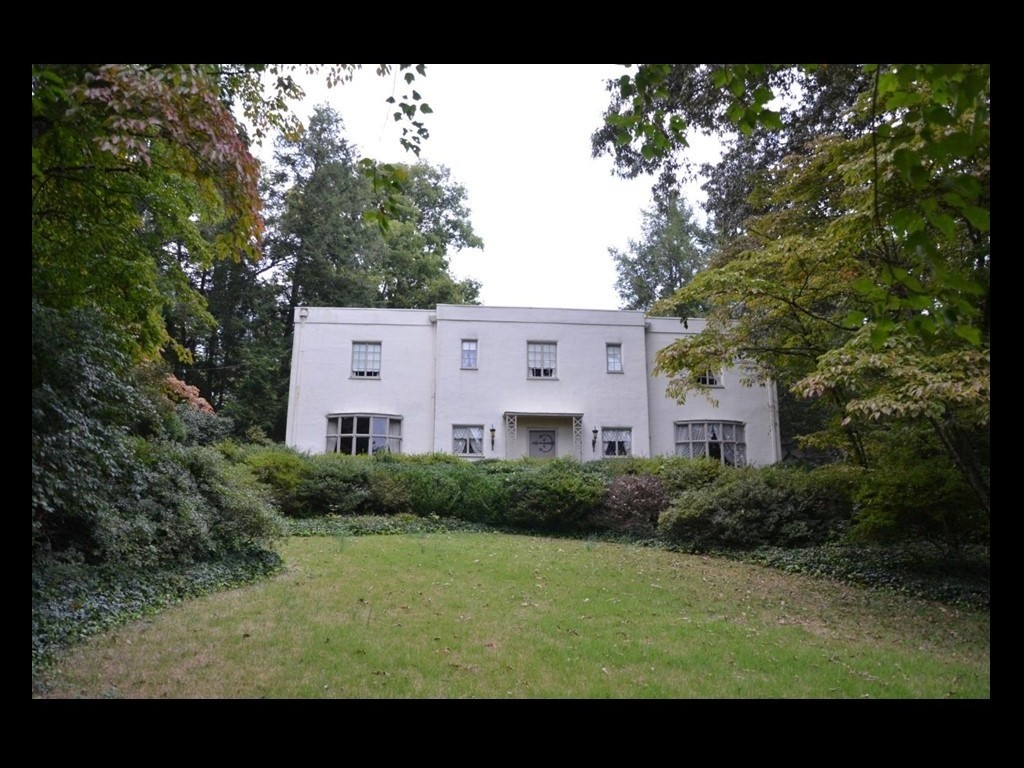For Mark Heinz, an architect who specializes in historic preservation, every older building has a story. But it’s safe to say none has proven as fascinating – or contained as much personality – as the home he and his wife, Laura, now live in with their three daughters.
The couple won a 2017 Preservation/Rehabilitation Award from Knox Heritage last month for their work on the Elizabeth Dunlap House on Scenic Drive in Sequoyah Hills. It was built in 1934 in the Art Moderne style, with a streamlined look, a flat roof, metal casement windows and other details that put it way ahead of its time.

Legendary photographer Jim Thompson took this photo of the Dunlap home in 1934.
Elizabeth Wiley Dunlap designed the home after seeing the Homes of Tomorrow exhibit at the 1933 World’s Fair in Chicago. It seems to be particularly based on the Good Housekeeping Stran-Steel House exhibited there.
Although there are other modern homes in the neighborhood now, when it was built, “it must have stuck out like it landed from Mars,” Mark Heinz marvels. “A big white spaceship.”
Mark is an architect with Dewhirst Properties, and Laura is an attorney. The Heinz family had just finished a renovation on Kenilworth in 2014 (“My wife had literally just hung her clothes in the closet,” he says) when he heard that the Dunlap home was for sale at an irresistible price. Although it took some sweet talk and a lot of sweat equity, the family renovated and expanded the house, adding a sunroom/breakfast room and additional bedroom as well as a carport. All of the renovations have been in keeping with Dunlap’s original vision.
Dunlap was the daughter of prominent merchant O.C. Wiley (the first employer of photographer Jim Thompson). She graduated from Knoxville High School in 1913 and went on to Smith College, then graduated from a prestigious landscape architecture program for women. After meeting her husband, Hobart, in Washington, D.C., the couple moved their young family to Knoxville in the 1920s.

The back of the house, with original azaleas from Hobart Dunlap’s own nursery.
With some money she had inherited, Dunlap picked up lots on Scenic Drive. She designed and built an elegant Tudor-style home on that street before embarking on her modern masterpiece.
From the 1930s to the 1960s, the local newspaper was full of clippings about the family – from Dunlap ice skating on the roof of her house in 1936 to stories about the important role she played in establishing Ijams as a nature park. Heinz has enjoyed getting to know Dunlap through these stories, and he’s had the added pleasure of spending time with Elizabeth and Hobart’s grandchildren and great-grandchildren and having them share photos and family tales.
History buff Bud Albers, who passed away in 2016, was the person who told Heinz that he had gone to the World’s Fair with the Dunlaps as a child. (Albers was also the one who told him that everyone in the neighborhood wondered “When are they going to put a roof on that thing?”)

Dunlap family photos with azaleas on the grounds. Bottom row center is one of the three Heinz daughters on the restored property.
Meeting Albers led to talking to others who had lived in Sequoyah Hills as children, who remembered wearing bathing suits under their clothes and racing to the pool from the elementary school. From family and community memories, this “rabbit hole” of finding out about the house has taken Heinz into correspondence with scholars studying architecture influenced by the 1933 World’s Fair and others specializing in women in landscape architecture.
Heinz has shared his own history of the house at the city of Knoxville’s PechaKucha night, where presenters share 20 slides for 20 seconds each. As longtime supporters of Knox Heritage, Laura and Mark Heinz opened the home up for a sold-out Summer Supper fundraiser for the organization last June. Heinz is currently researching whether the home was the first true modern residence within city limits, which would make Dunlap’s achievement all the more marvelous.
“It’s fascinating for a woman to have done a modern building in the South in the 1930s,” Heinz says. “She was so far ahead of her time.”

